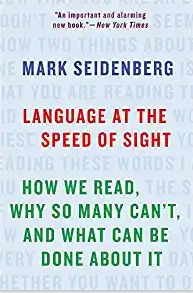I’ve just read Mark Seidenberg’s Language at the Speed of Sight. He’s a co-leader of the Language & Cognitive Neuroscience Lab at the University of Wisconsin in Madison. The book is filled with details about the science of reading and the conclusions reached through several decades of research. There is still a major question: why doesn’t reading science impact the teaching of reading?
In the first chapter, titled “The Problem and the Paradox,” Seidenberg explains that he has been studying reading since the disco era. I figure that must mean some time in the 1970s. I’ll do the math: that’s between forty and fifty years. He’s not alone either; he’s part of a huge community of scientists around the world. According to Seidenberg, “We’ve learned quote a lot actually.” In fact, he specifies a long list of “knowns” that include the following:
- basic mechanisms that support skilled reading;
- which behaviors of three- and four-year-olds predict later reading ability;
- how children become readers;
- what distinguishes readers of different ages and skill levels; and
- the mail causes of reading impairment.
This is not his complete list, but, this alone is an impressive cache of knowledge.
So, What’s the Problem?
We have a literacy problem in the U.S., Seidenberg asserts, “The country is a chronic underachiever.” The National Assessment of Adult Literacy (NAAL) study results from 2003 claimed that about 93 million adults could only read at or below the basic level. By the way, NAAL determined that this represented 43% of the adult population at the time. Mark Seidenberg translated these disastrous statistics this way, “At those levels, a person might be able to follow the instructions for mixing a batch of cake mix but not understand a fact sheet on high blood pressure.”
That sounds pretty serious, but it gets worse. Seidenberg cites the NAEP results over time, demonstrating that more than half of our children score at or below the basic reading level. This has been true since the tests began in 1990. Math again! That’s 31 years.
Consequences of Marginal Literacy
As a reading scientist, Seidenberg asserts that the consequences of marginal literacy are vast. He gives several examples:
- Reading is fundamental. Therefore, a child’s failure to acquire reading skills has “rapidly cascading effects” on learning other subjects.
- “Having less reading experience makes it harder to learn how to learn and how to think critically and analytically,” according to Seidenberg.
- Poor reading skills put students in a high-risk category for falling out of the education system.
Again, this may not shock you. We have continued to take a “ho-hum” attitude about our failing education system for decades. However, it deserves serious attention, such as it got in a 2012 report from the Council of Foreign Relations. Seidenberg quotes from the think tank’s report, stating, “Large, undereducated swaths of the population damage the ability of the United States to physically defend itself, protect its secure information, conduct diplomacy, and grow its economy.”
What’s Causing This Chronic Mediocrity in Reading?
The classic response to this question is this: poverty is the reason for our struggles with reading. Poverty is certainly one of the factors, but it is not the only. Furthermore, it may not be the most important. The 93 million adults who are marginal readers are not confined to the lowest socioeconomic class.
There are what Seidenberg calls “constitutional” factors like hearing or learning impairment. And, in fact, dialect is an interesting issue impacting reading success. There are about 30 major dialects spoken in American with some having minor sub-dialects. To one extent or another, dialects function a bit like a foreign language. Books are written in Mainstream American English (MAE) with which a dialect speaker will be less familiar.
However, Seidenberg deals extensively with the relationship between speech and reading. He calls it “an intimate but complex relationship” and says it underlines many of the scientific questions and educational controversies about reading. “Children’s progress in learning to read is greatly affected by their experience with spoken language.” I chronicled this in a previous blog, entitled “30 Million Words.”
Beyond these factors, the most influential consideration for reading success is reading instruction.
Paradox: Why Doesn’t The Science of Reading Impact the Teaching of Reading?
Reading scientists and the education establishment (which will include the teachers and their unions, the book publishers, and the teacher education schools) appear to agree on one point. It is that skilled reading depends on students being able to recognize and understand enough words on a page to extract meaning. What they do not and may never agree on is the method for achieving that goal.
For almost 100 years, educators and the educators of educators have altered teaching methods for reading instruction. They have turned their backs on the methods used for generations before the twentieth century. They have eschewed phonics and any approach that requires rote memorization. At the same time, the advances in reading research have concluded that education is moving in precisely the wrong direction.
Educators choose to focus on teaching words while science demands the teaching of sounds and letters. Educators embrace strategies such as “whole language” and its recent cousin “balanced literacy,” rather than provide the explicit phonics instruction that will improve students’ chances of becoming skilled readers. As Mark Seidenberg put it, “The answer is the same for all children. Cultural, economic, and education circumstances obviously affect children’s progress, but what they need to learn does not change.”
What Must Change?
The worlds of science and education, while having a common focus, reading instruction, have little in common otherwise. The education establishment opposes phonics instruction. The conclusion of reading scientists is that phonics must not only be included but must be explicit and thorough.
Perhaps teaching whole words looks like the shortcut to reading. This boggles the mind. How long will it take to teach a student even 100,000 of the 650,000 possible words in English? In fact, it is critical to a child’s success in reading that he or she grasp the “alphabetic principle” that letters represent sounds. This is the secret shortcut to decoding most of our words!
The promotion of the “balanced literacy” approach, which supposedly combines a bit of everything has not been producing results. However, as Seidenberg points out, it does allow educators “to declare an end to the increasingly troublesome ‘wars’ without resolving the underlying issues.
Poverty, impairment, dialects, and other factors surely deserve out attention long term. Unfortunately, our experience dictates that we will not solve poverty any time soon. However, we can change our instructional practices to align with reading science and offer our students a better chance of success.

